Useful properties and calorie content of rice
Rice is a healthy product that is part of dietary and therapeutic menus. The energy value and calorie content of the product depend on the type, and this should be taken into account when preparing a rational and balanced diet. Knowing its beneficial properties, you can correct pathological symptoms. There are also contraindications that need to be taken into account.
We will tell you about the benefits and harms of rice, how many calories and carbohydrates there are in rice, in this article.
Chemical composition and trace elements of rice
Rice is one of the main grains in the Russian diet, along with buckwheat, oatmeal, peas and millet. It is used as a side dish, added to salads, soups, minced meat and pies. How many calories, proteins, fats and carbohydrates are in rice?
100 g of dry product contains:
- 300 kcal;
- 7.6 g protein;
- 2.6 g fat;
- 62.3 g carbohydrates.
Included there is fiber – 9.8 g per 100 g of cereal.
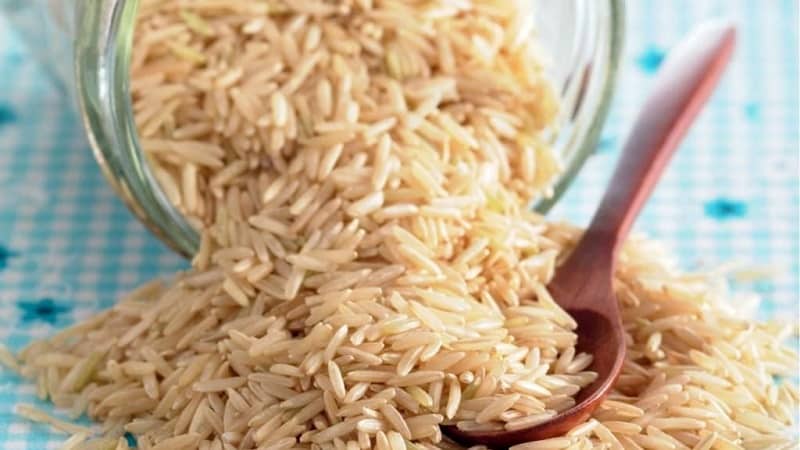
Glycemic index rice cereal is 60 units.
Microelements – magnesium, phosphorus, selenium, copper and manganese – satisfy the daily need for these elements by more than 30%.
Important! Rice satisfies 20% of the daily requirement for essential amino acids.
Calorie content and nutritional value of different types of rice
The calorie content of cereals and its composition vary depending on the type. Some varieties are lower in calories, up to 20%, which is especially important for those losing weight. The protein content also varies - in some types it is twice as much.
Calorie table and BZHU different types of rice.
| Type of rice | Kcal per 100 g | Proteins, g | Fats, g | Carbohydrates, g |
| White | 268 | 5,48 | 0,76 | 63 |
| Brown | 303 | 6,3 | 2,9 | 62 |
| Black | 220 | 7,07 | 1,6 | 45 |
| Wild | 288 | 10,3 | 0,7 | 53 |
| Red | 320 | 7,5 | 2,6 | 64 |
| Basmati | 338 | 7,75 | 0,66 | 75 |
| Jasmine | 349 | 7,2 | 0,4 | 78 |
*Data given for raw product
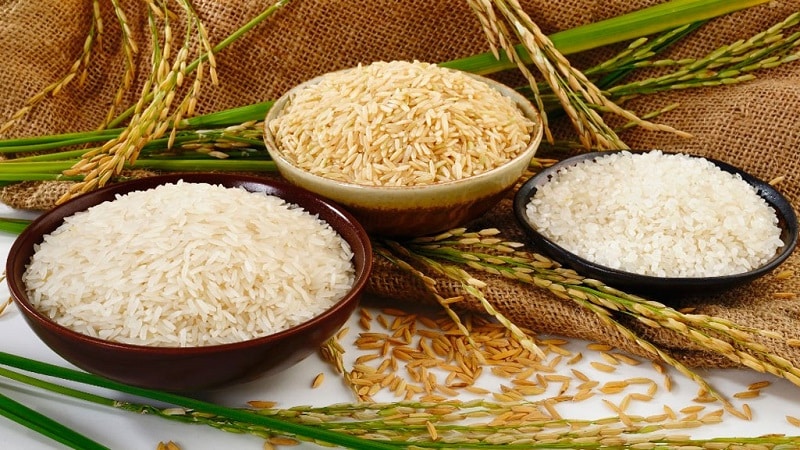
Calorie content and BZHU depending on the method of preparation
The calorie content and nutritional value of rice vary depending on the cooking method. The data in the table is given for white. Rice with additives is calculated for the cereal/additive ratio – 60%/40%.
| Cooking method | Kcal per 100 g | Proteins, g | Fats, g | Carbohydrates, g |
| Boiled in water | 110,6 | 2,2 | 0,46 | 23 |
| With salt | 122 | 2,4 | 0,6 | 27 |
| Without salt | 227 | 5,6 | 1,5 | 50 |
| With butter | 124,5 | 4,6 | 8,6 | 51 |
| With carrots | 130 | 3 | 7,2 | 60 |
| With mushrooms | 165 | 3,9 | 3,7 | 54 |
| With broccoli | 250 | 11,9 | 3,4 | 65 |
| Undercooked | 230 | 4,22 | 0,62 | 49 |
Undercooked cereals are classified as raw foods.. It is not saturated with water, so its caloric content and energy value are significantly higher than that of rice aged until fully cooked.
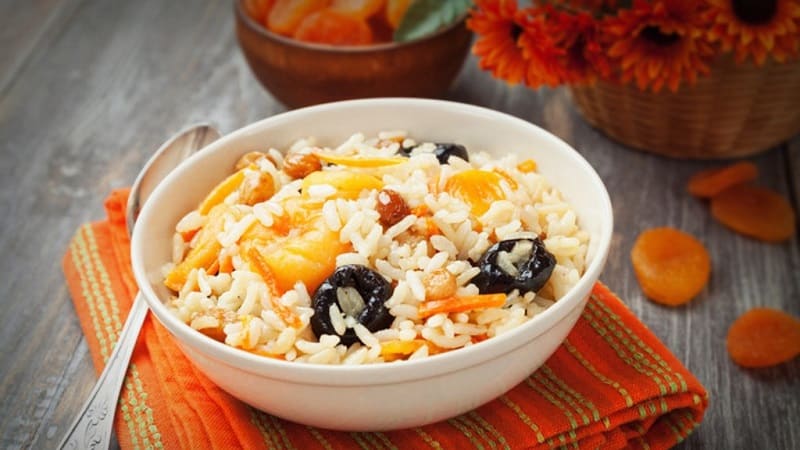
Nutritional value of rice dishes
In ready-made multi-component dishes, calorie content is more difficult to calculate, since, in addition to rice, it includes other ingredients. The combination of cereals with vegetables makes the dish rich in vitamins and fiber, and if meat is included in the composition, the product will contain more proteins and fats.
Approximate calorie content of famous dishes with rice, per 100 g:
- pilaf – 210 kcal;
- cabbage rolls – 156 kcal;
- rice soup with chicken – 67 kcal;
- stuffed peppers – 160 kcal;
- meatballs in tomato sauce – 154 kcal;
- salad with rice and crab sticks – 201 kcal.
Useful properties and vitamins of rice
Rice contains vitamins:
- Thiamine (B1) – 0.35 mg. Responsible for the functioning of the nervous system and muscles, coordination of movements and mental activity.
- Riboflavin (B2) – 0.08 mg. Needed for the normal functioning of the immune system, red blood cells, and reproductive organs. Affects the condition of the skin, nails and hair, and the function of the thyroid gland.
- Niacin (B3/PP) – 5.3 mg.Normalizes lipid metabolism at the level of the whole organism, has a positive effect on blood vessels and improves the condition of the microvasculature.
- Choline (B4) – 85 mg. Supports the functioning of neurotransmitter systems, regulates insulin synthesis, promotes the processing of fats in the liver.
- Pantothenic acid (B5) – 0.7 mg. Participates in the regulation of the adrenal glands, the formation of antibodies, lipid metabolism, regulates gastrointestinal motility, and affects blood cholesterol levels.
- Pyridoxine (B6) – 0.55 mg. Participates in the life cycle of red blood cells, stimulates the nutrition of brain cells and their absorption of glucose, participates in the metabolism of fats and proteins, and reduces cholesterol levels.
- Folic acid (B9) – 35 mcg. Participates in the development of the nervous system, regulates the division and maturation of red blood cells in the bone marrow.
- Tocopherol (E) – 0.8 mg. Naturally occurring antioxidant. Protects cells from the harmful effects of free radicals.
- Biotin (H) – 12 mcg. Regulates protein, fat and carbohydrate metabolism, promotes collagen production.
The rich vitamin composition makes rice an indispensable product. on the menu of people with various diseases.
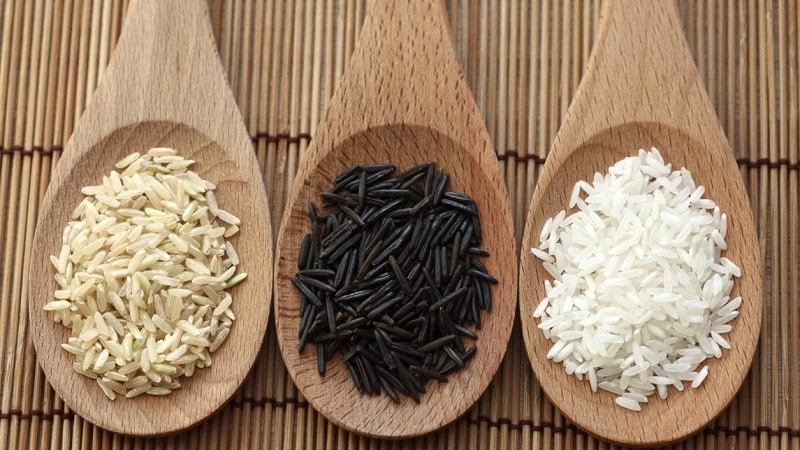
Benefits for the human body
What are the benefits of rice for the body?:
- For the heart and blood vessels. Rich in potassium, which is necessary for heart function.
- For the kidneys. Reduces swelling, removes salts from the body.
- For the stomach. It has an enveloping effect, reduces the harmful effects of excess hydrochloric acid, therefore it is useful for peptic ulcers and hyperacid gastritis.
- For diseases of the pancreas. Useful for patients with pancreatitis even during the period of exacerbation from 2-3 days in the form of ground porridge and soup. It is well absorbed, adsorbs toxins, and eliminates loose stools.
- It does not contain gluten, so it is indicated for patients with celiac disease - a defect in the enzyme that breaks down gluten.
- Rich in fiber and starch. As a natural sorbent, it is recommended to use it for food poisoning to help the body remove toxic substances.
Benefits for men: enhances testosterone production, in combination with seafood serves as an aphrodisiac. Therefore, sushi and rolls are a good choice for a romantic dinner for two.
Benefits for women: Rice is hypoallergenic, which means it can be consumed by nursing mothers. Decoctions and masks from it have found use in cosmetology for rejuvenation, improvement of complexion and mattification of the skin. A decoction with the juice of half a lemon relieves skin pigmentation during pregnancy. Rice water left after soaking rice or drained from boiled rice is used to rinse hair. It makes them stronger, more obedient and shiny.
For children: one of the first cereals in complementary foods is rice. It envelops the walls of the gastrointestinal tract and relieves irritation. The organic substances contained in the composition are involved in the formation of the nervous system and strengthen the immune system.
Important! Rice is a source of energy. It contains a lot of carbohydrates, but little fat, so it is definitely included in the diet of athletes.
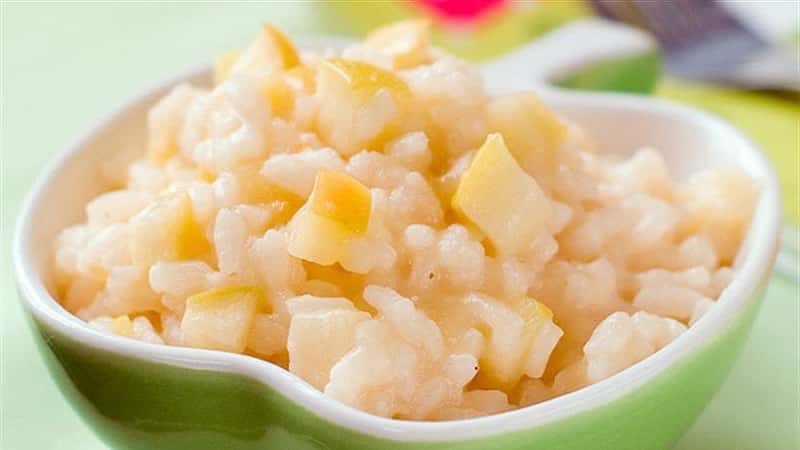
Consumption rate
For our country, rice is not a traditional product historically. Therefore, you should not eat it every day - the body is not adapted to it.
According to the Ministry of Health, one Russian citizen relies on 7 kg of cereal per year. This means that it is safe for health to eat a portion of 150 g once a week; on the remaining days of the week it can be present in the diet as a component of other dishes - in soup, minced meat.
Possible harm and contraindications
Rice is a healthy product, but some people need to limit its consumption.
People with diabetes should reduce their rice intakebecause it contains a lot of starch. When compiling a diet, you need to take into account the glycemic index of this cereal. Consuming large amounts may cause a sharp increase in blood glucose levels.
Due to the risk of constipation, it should be limited to people with diseases of the gastrointestinal tract, pregnant women and those suffering from heart and vascular diseases, as blood pressure increases due to pushing.
Rice based diets
Rice has a low calorie content, so it is often included in various dietary plans.. There are also mono-diets based on it. The product meets the requirements of proper nutrition, therefore it is considered a suitable side dish for chicken breast, veal, fish and seafood.
Rice
There are many varieties rice diet.
For example:
- Hard option. Pour one glass of rice with two glasses of cold water in the evening. In the morning, divide the resulting mushy mass into several parts and eat throughout the day. You cannot add sugar, salt, spices and honey. It is important to drink enough liquid - water or green tea.
- Soft option – eating rice in combination with fruits (apple, orange), berries, vegetables (carrots, zucchini, broccoli, peppers), mushrooms and chicken. It is important to drink at least 2 liters of fluid per day - 30 ml per 1 kg of body weight.
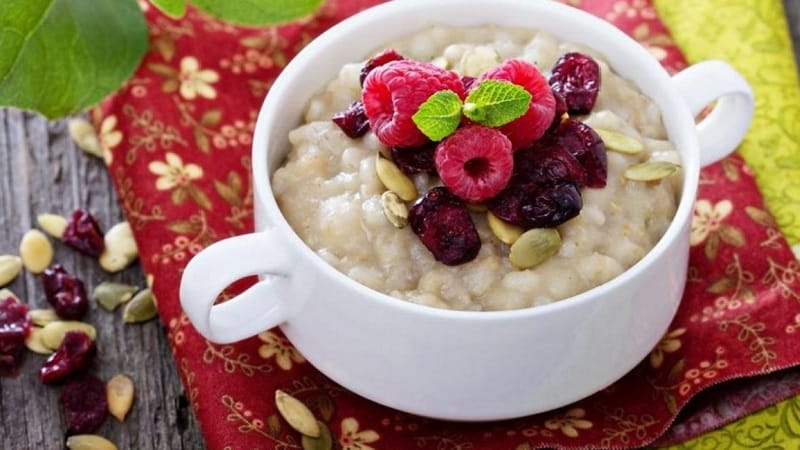
Honey-rice
A very strict but effective diet. Contraindicated for people allergic to honey. The diet consists of 5 meals - 100 g of rice or rice porridge with water in each. Also during the day you need to drink a drink of honey and lemon - a glass every 8 hours.
Rice-buckwheat
More balanced than strict diets on rice.
The principle is this:
- in the morning – fruit salad;
- in the afternoon - rice and a small amount of nuts;
- for an afternoon snack - vegetable salad with herbs;
- in the evening - buckwheat with chicken or steamed fish.
It’s easier to stick to such a diet, and the results are no worse.
Geisha diet
The strict conditions of this diet indicate that a chiseled figure was not easy for Japanese beauties. You can stick to it for no more than a week. After it, not only kilograms and volumes disappear, but also the condition of the skin and overall well-being improve.
For breakfast you need to drink 500 ml of green tea with milk, for lunch - 300 g of boiled brown rice with 500 ml of green tea, for dinner - the same as for lunch.
Conclusion
Rice is useful as a separate product and is used as part of other dishes. Based on it, you can create a balanced and nutritious diet for people with chronic diseases, including obesity. When drawing up a dietary menu, you should take into account the type of product and the method of its preparation.